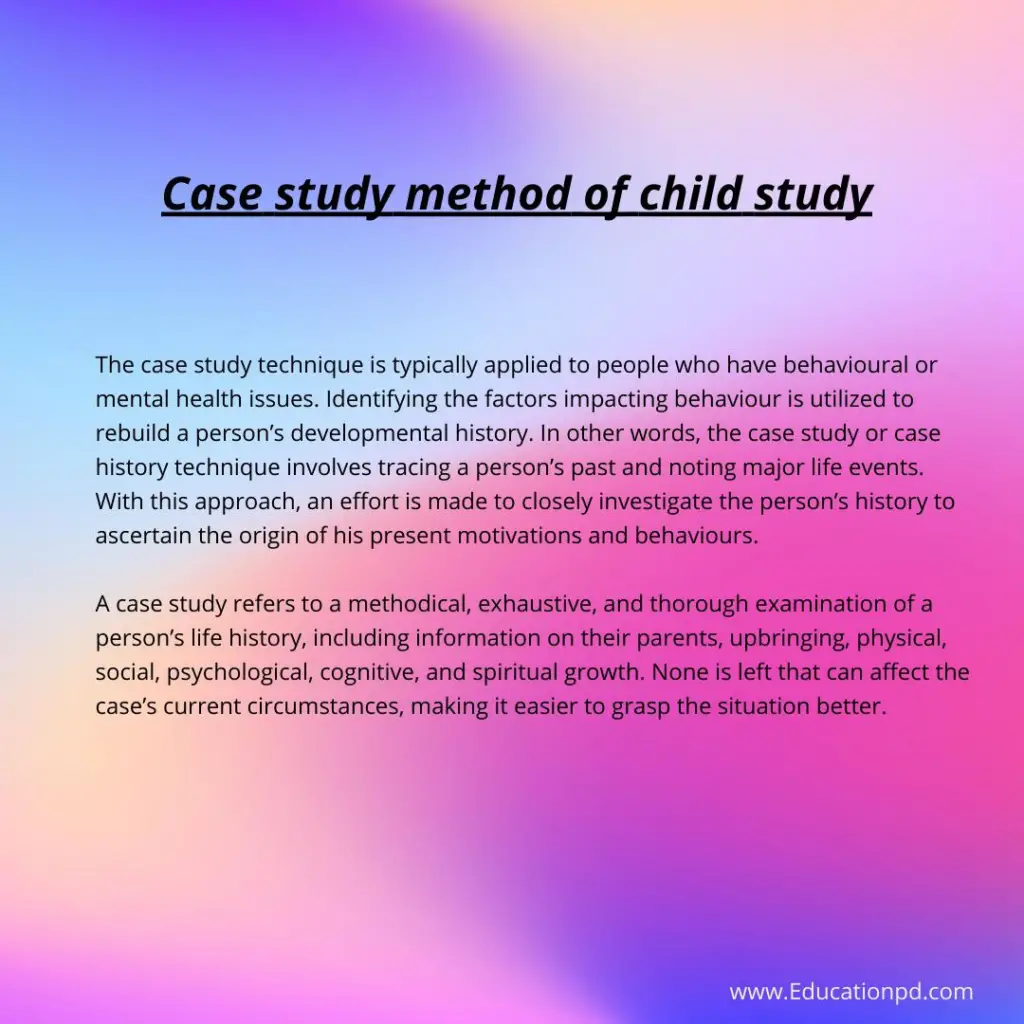Back to: Early Childhood Care and Education B.ed Notes, IGNOU Notes, M.A Notes, Graduation Notes
Methods of studying child behaviour observation and case study
The collecting and organizing of credible data can be aided by the use of unique instruments, processes, or methodologies in child research. According to Charles Gide, the word “method” refers to the path that must be taken to get at the truth; there are numerous ways that are employed in child psychology. To gather data, psychologists employ a variety of techniques, including observation, experimentation, correlation, surveys, psychological testing, case studies, etc. This article discusses some of the significant techniques that are frequently applied in early childhood development.

Observation method of studying child behaviour
A particularly effective tool for psychological research is observation. It is a useful technique for understanding human behaviour. We spend the entire day in our regular lives observing various things. We frequently fail to realize what we are seeing or have already seen. Although we see, we do not monitor. Only a small portion of what we see every day escapes our awareness. Scientific observation is very different from regular observation.
- Selection: Scientists do not always observe every behaviour they come across. Instead, they pick a certain activity to study.
- Recording: A researcher will follow remarks, record counts for previously defined behaviours every time they arise, describe each event in more detail using abbreviations or figures, and take pictures, video footage, or other methods while they are watching.
- Analysis: Following making their observations, analysts examine the information they have gathered to try and make sense of it. It is crucial to understand that making accurate assessments requires competence. A skilled observer is aware of what he is looking for, whom he wants to read about, when and where the observation has to be performed, how it will be documented, and how to interpret the behaviour they have seen.

Types of Observation Methods in Childcare
- Naturalistic vs. controlled observation: Naturalistic observation refers to the process of making observations in a natural or real-world environment. In this instance, the observer doesn’t try to influence or manipulate the circumstances to conclude. These kinds of observations are made in places like hospitals, residences, classrooms, daycare facilities, etc. Yet, since they are not the subject of our study, there are many instances when you may need to manage certain aspects that affect behaviour. This is why a lot of psychological research uses controlled observation, which is done in lab settings.
- Non-Participant vs. Participant Observation: One can observe in two different ways. The observer has the option to see the subject or event far away (non-participant observation). The observer could also merge with the group being scrutinized. In the first scenario, the subject of the observation could not be conscious of it.
For example, we’d like to look at how the professors and students in a specific class communicate with one another. This objective can be attained in a variety of ways. The spectator may use a video camera to monitor the happenings in the lecture. He could also choose to remain seated in a quiet area of the classroom and refrain from meddling with or engaging in their regular activities. Non-participant observation is the term for this kind of observation.
When doing participant observation, the investigator joins the class or organization being scrutinized. In participant observation, the analyst spends some time getting to know the members of the group so they begin to appreciate him as a member of the group. Nevertheless, based on the study’s main objective, the spectator’s level of connection with the group under observation may change.

Experimental method of child study
In a controlled environment, experiments are often carried out to determine the cause-and-effect relationship between two sets of occurrences or factors. It is a meticulously planned process where adjustments are made to one aspect and the impact on some other element is examined. In the research, the altered or controlled event is the reason. The impact is the modification in behaviour brought on through influence.
Experiments can be controlled through various techniques:
- The easiest method to solve this issue is to remove unnecessary factors from the experimental setup because the purpose of an experiment is to reduce superfluous factors. For example, the study may be carried out in a quiet area with air conditioning to reduce the impact of disturbance and climate.
- It’s not always possible to avoid. When this occurs, actions should be taken to maintain them consistently so that their impact is consistent across the duration of the experiment.
- Any possible systematic disparities between organizations are eliminated by randomly assigning individuals to multiple organizations.

Case study method of child study
The case study technique is typically applied to people who have behavioural or mental health issues. Identifying the factors impacting behaviour is utilized to rebuild a person’s developmental history. In other words, the case study or case history technique involves tracing a person’s past and noting major life events. With this approach, an effort is made to closely investigate the person’s history to ascertain the origin of his present motivations and behaviours.
A case study refers to a methodical, exhaustive, and thorough examination of a person’s life history, including information on their parents, upbringing, physical, social, psychological, cognitive, and spiritual growth. None is left that can affect the case’s current circumstances, making it easier to grasp the situation better.
